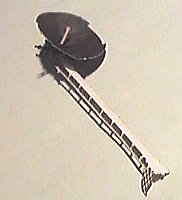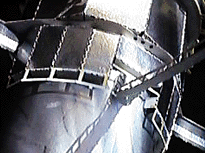7. INSTALL THE HIGH-GAIN ANTENNAS.
View the whole assembled model
HST has two steerable High-Gain Antennas. These are used for communications: receiving commands and sending science data and spacecraft health data. They maintain point on TDRSS satellites (Tracking and Rata Relay Satellite System) which in turn communicate with Earth -- the people at the Space Telescope Science Institute.

- From sheet B, release one black HIGH-GAIN ANTENNA. (HGA) Identify the two wedge cuts. Apply glue beside one wedge cut, and overlap the adjacent section onto the glue 1/8 inch (2mm) at most, so the flat circle begins to bend into a shallow cone. Hold until dry. It helps to squeeze the seam with long-nose pliers. Repeat for the remaining wedge cut. You should end up with a shallow cone shape.
- From sheet B, release an HGA BOOM. Fold the crosshatched panel, together with its attached runner, 90 degrees toward the white surface (either direction), forming an L-shaped beam. Bend the entire black end-part over 90 degrees to the boom (either direction).
- Insert the white protrusion at the end of the HGA BOOM into the slot on the HGA, bringing the crescent-shaped part up to the slot. The white protrusion ends up inside the HGA bowl. Center it up and secure with glue.
- Repeat the above three steps with the other HIGH-GAIN ANTENNA and HGA BOOM.
- Set the telescope down lengthwise, with the keel fitting resting on your work surface, and immobilize it. Apply some glue to the tube in an L shape in the location shown here, even with the top of the equipment bays. This is a good place to use a hot-glue gun if you are comfortable using one.

- Apply glue to the L-shaped base of the HGA boom. Allow it, and the L-shaped glue application on the TELESCOPE TUBE to set until they are about half-dry.
- Place the glue-covered, L-shaped base of the HGA boom down onto the L-shaped glue patch on the TELESCOPE TUBE. Hold it until thoroughly dry, with the HGA boom standing straight out from the TELESCOPE TUBE. It does not matter which way the HGA dish faces, since it is free to articulate on the actual spacecraft, but the HGA BOOM must come out perpendicular to the SLOAR ARRAY SUPPORTS.
- In a similar manner, glue the other HGA BOOM to stand straight out from the other side of the TELESCOPE TUBE. The two HGA BOOMs should be exactly in line with each other. When you look down the telescope tube, you should see the SOLAR ARRAY SUPPORTS and the HGA BOOMS exactly perpendicular, and aligned with the SPIDER inside.




